Evaluating the Impact of Engineering Works in Megatidal Areas Using Satellite Images—Case of the Mont-Saint-Michel Bay, France
Abstract
:1. Introduction
2. Materials and Methods
2.1. Study Site
2.2. The Sediments in the Bay
2.3. Restoring the Maritime Character of Mont-Saint-Michel
2.4. Previous Remote Sensing Studies
3. Methods
3.1. Acquisition of Remote Sensing Data
3.2. Definition of the Tidal Parameters and Satellite Data Pre-Processing
3.3. Spectral Ranges
- -
- The RGB true colour composite (R = red range, i.e., S2-band 4 or Alos-band 3; G = green range, i.e., S2-band 3 or Alos-band 2; B = blue range, i.e., S2-band 2 or Alos-band 1). Due to the lack of the blue range in the Aster data, the true colour composite cannot be obtained with this sensor. The true colour composite is interesting for a global approach of the tidal flats, but it is sometimes difficult to accurately detect the limit between the vegetation front (especially in wintertime), the humid sediments, and the water in the channels due to the turbidity (Figure 4, bands 2–4, turbid water and humid sediments).
- -
- The RGB standard false colour composite (R = near infrared range, i.e., S2-band 8 or Alos-band 4 or Aster-band 3N; G = red range, i.e., S2-band 4 or Alos-band 3 or Aster-band 2; B = green range, i.e., S2-band 3 or Alos-band 2 or Aster-band 1). The edge of the schorre is easier to detect on the standard false colour composite because the reflectance of vegetation is high in the near infrared (Figure 4, vegetation, band 8), whatever the season of acquisition. The contrast is less marked on the true colour composite.
- -
- A black-and-white image of the near infrared range (S2-band 8 or Alos-band 4 or Aster-band 3N). This image is better for distinguishing between water and humid sediments (Figure 4, band 8, turbid water and humid sediments).
- -
- A RGB false colour composite at 20 m resolution including only infrared ranges (R = near IR range, i.e., S2-band 8A; G = mid-IR range, i.e., S11-band 3; B = short waves IR range, i.e., S2-band 12). The IR false colour composite is useful for distinguishing between the waterbodies (black) and the land surfaces (clear), with the different kinds of vegetation in shades of red (Figure 4, bands 8–11–12, vegetation).
3.4. Mapping
4. Results
4.1. The Schorre (Vegetation Frontline)
4.2. Evolution of the Channels
4.2.1. The Western Channel (Couesnon W, Figure 7)

4.2.2. The Eastern Channel (Couesnon E, Figure 7)
4.2.3. The Sée-Sélune Estuary (Figure 7)
4.3. Sedimentary Balance
5. Discussion
5.1. Evolution Close to the Mont
5.2. Evolution of the Inner Part of the Bay du Mont-Saint-Michel
5.3. A Tentative Volumetric Approach
5.4. The End-User Engagement
6. Conclusions
Supplementary Materials
Funding
Data Availability Statement
Acknowledgments
Conflicts of Interest
References
- Reed, D.J.; Davidson-Arnott, R.; Perillo, G.M.E. Estuaries, coastal marshes, tidal flats and coastal dunes. In Geomorphology and Global Environmental Change; Slaymaker, O., Spencer, T., Embleton-Hamann, C., Eds.; Cambridge University Press: Cambridge, UK, 2015; pp. 130–152. [Google Scholar]
- Semeniuk, V. Tidal flats. In Encyclopedia of Coastal Science; Finkl, C.W., Makowski, C., Eds.; Springer: Berlin/Heidelberg, Germany, 2019; Volume 36, pp. 1708–1727. [Google Scholar]
- Kang, Y.; Lei, J.; Wang, M.; Li, G.; Ding, X. Topographic evolution of tidal flats based on remote sensing: An example in Jiangsu coast, Southern Yellow Sea. Front. Mar. Sci. 2023, 10, 1163302. [Google Scholar] [CrossRef]
- Cohen, M.C.L.; de Souza, A.V.; Liu, K.-B.; Rodrigues, E.; Yao, Q.; Pessenda, L.C.R.; Rossetti, D.; Ryu, J.; Dietz, M. Effects of Beach Nourishment Project on Coastal Geomorphology and Mangrove Dynamics in Southern Louisiana, USA. Remote Sens. 2021, 13, 2688. [Google Scholar] [CrossRef]
- Cracknell, A. Remote sensing techniques in estuaries and coastal zones—An update. Int. J. Remote Sens. 1979, 20, 485–496. [Google Scholar] [CrossRef]
- Benveniste, J.; Mandea, M.; Melet, A.; Ferrier, P. Earth observations for coastal hazards monitoring and international services: A European perspective. Surv. Geophys. 2020, 41, 1185–1208. [Google Scholar] [CrossRef]
- Murray, N.J.; Phinn, S.R.; DeWitt, M.; Ferrari, R.; Johnston, R.; Lyon, M.B.; Clinton, N.; Thau, D.; Fuller, R.A. The global distribution and trajectory of tidal flats. Nature 2019, 565, 222–225. [Google Scholar] [CrossRef] [PubMed]
- Gawehn, M.; van Dongeren, A.; de Vries, S.; Swinkels, C.; Hoekstra, R.; Aarninkhof, S.; Friedman, J. The application of a radar-based depth inversion method to monitor near-shore nourishments on an open sandy coast and an ebb-tidal delta. Coast. Eng. 2020, 159, 103716. [Google Scholar] [CrossRef]
- Kohlus, J.; Stelzer, K.; Müller, G.; Smollich, S. Mapping seagrass (Zostera) by remote sensing in the Schleswig-Holstein Wadden Sea. Estuar. Coast. Shelf Sci. 2020, 238, 106699. [Google Scholar] [CrossRef]
- Madhuanand, L.; Philippart, C.J.M.; Wang, J.; Nijland, W.; de Jong, S.M.; Bijleveld, A.I.; Addink, E.A. Enhancing the predictive performance of remote sensing for ecological variables of tidal flats using encoded features from a deep learning model. GISci. Remote Sens. 2023, 60, 2163048. [Google Scholar] [CrossRef]
- Mason, D.C.; Scott, T.R.; Dance, S.L. Remote sensing of intertidal morphological change in Morecambe Bay, U.K., between 1991 and 2007. Estuar. Coast. Shelf Sci. 2010, 87, 487–496. [Google Scholar] [CrossRef]
- Ryu, J.H.; Choi, J.K.; Lee, Y.K. Potential of remote sensing in management of tidal flats: A case study of thematic mapping in the Korean tidal flats. Ocean Coast. Manag. 2014, 102, 458–470. [Google Scholar] [CrossRef]
- Zhang, N.; Li, H.; Zhang, J.; Chen, J.; Wu, H.; Gong, Z. Study of the spatial and temporal distributions of tidal flat surface sediment based on multitemporal remote sensing. Front. Mar. Sci. 2023, 10, 1109146. [Google Scholar] [CrossRef]
- Tong, S.S.; Deroin, J.P.; Pham, T.L. An optimal waterline approach for studying tidal flat morphological changes using remote sensing data: A case of the northern coast of Vietnam. Estuar. Coast. Shelf Sci. 2020, 236, 106613. [Google Scholar] [CrossRef]
- Salameh, E.; Frappart, F.; Turkia, I.; Laignel, B. Intertidal topography mapping using the waterline method from Sentinel-1 & -2 images: The examples of Arcachon and Veys Bays in France. ISPRS J. Photogramm. Remote Sens. 2020, 163, 98–120. [Google Scholar]
- Deroin, J.P.; Guillaneuf, A.; Laratte, S. A multisource approach for tidal flat study. Example of the Baie des Veys, Normandy, France. Z. Geomorph. 2022, 64, 17–38. [Google Scholar] [CrossRef]
- Deroin, J.P.; Marchand, Y.; Auffret, J.P. Littoral survey using the JERS-OPS multispectral sensor. Example of the Mont Saint-Michel Bay (Normandy, France). Remote Sens. Environ. 1997, 62, 2–119. [Google Scholar] [CrossRef]
- Verger, F. Marais de Dol et Baie du Mont-Saint-Michel. In Zones Humides du Littoral Français: Estuaires, Deltas, Marais et Lagunes; BELIN Ed.: Paris, France, 2009; pp. 177–201. [Google Scholar]
- Phlipponneau, M. La Baie du Mont-Saint-Michel. Etude de Morphologie Littorale. Ph.D. Thesis, University of Paris, Paris, France, 1955. [Google Scholar]
- Larsonneur, C. La Baie du Mont-Saint-Michel: Un modèle de sédimentation en zone tempérée. Bull. Inst. Géol. Bassin d’Aquitaine 1989, 46, 5–73. [Google Scholar]
- L’Homer, A.; Courbouleix, S.; Chantraine, J.; Deroin, J.P. Baie du Mont-Saint-Michel. In Geological Map of France at 1, 50,000; BRGM, Ed.; French Geological Survey: Orléans, France, 1999; Volume 208, 184p. [Google Scholar]
- Bonnot-Courtois, C.; Caline, B.; L’Homer, A.; Le Vot, M. La Baie du Mont Saint-Michel et l’estuaire de la Rance. Environnements sédimentaires, aménagements et évolution récente. In Bulletin des Centres de Recherches Exploration—Production; Elf-Aquitaine: Paris, France, 2002; Volume 26, 256p. [Google Scholar]
- Tessier, B.; Billeaud, I.; Lesueur, P. Stratigraphic organisation of a composite macrotidal wedge: The Holocene sedimentary infilling of the Mont-Saint-Michel Bay (NW France). Bull. Soc. Geol. Fr. 2010, 181, 99–113. [Google Scholar] [CrossRef]
- Deroin, J.P.; Shimada, M. The importance of local mean time in remote sensing for mapping megatidal zones. Comptes Rendus Geosci. 2010, 342, 11–18. [Google Scholar] [CrossRef]
- Verger, F. Colmatage et génie civil aux environs du Mont-Saint-Michel. Mappemonde 2001, 63, 25–28. [Google Scholar] [CrossRef]
- Viguier, J.; De Croutte, E.; Hamm, L. Hydrosedimentary studies to restore the maritime character of Mont-Saint-Michel. In Proceedings of the Coastal Engineering Conference, Cardiff, UK, 7–12 July 2002; World Scientific Publishers: Singapore, 2003; pp. 3285–3297. [Google Scholar]
- Migniot, C.; Viguier, J. The silting-up around Mont-Saint-Michel and the method used to maintain its maritime character. In Bulletin des Centres de Recherches Exploration—Production; Bonnot-Courtois, C., Caline, B., L’Homer, A., Le Vot, M., Eds.; Elf-Aquitaine: Paris, France, 2002; pp. 125–152. [Google Scholar]
- Marchand, Y.; Deroin, J.-P.; Auffret, J.-P. Morphodynamics of the Mont Saint-Michel Bay (West France) since 1986 by remote sensing data. Comptes Rendus Acad. Sci. 1998, 327, 155–159. [Google Scholar]
- Bilodeau, C.; Deffontaines, B.; Deroin, J.P.; Radureau, A.; Cohen, M. Estimation du potentiel des données LIDAR multi-échos pour l’étude de la végétation des marais salés: Étude du biais des données LIDAR acquises au-dessus de la baie du Mont Saint-Michel et recherche d’une méthode de correction. Revue Soc. Franç. Photogramm. Télédétect. 2010, 192, 189–190. [Google Scholar]
- Levoy, F.; Anthony, E.J.; Dronkers, J.; Monfort, O.; Montreuil, A. L Short-term to decadal-scale sand flat morphodynamics and sediment balance of a megatidal bay: Insight from multiple LiDAR datasets. J. Coastal Res. 2019, 88, 61–76. [Google Scholar] [CrossRef]
- Cosma, M.; Lague, D.; D’Alpaos, A.; Leroux, J.; Feldmann, B.; Ghinassi, M. Sedimentology of a hypertidal point bar (Mont-Saint-Michel Bay, north-western France) revealed by combining lidar time-series and sedimentary core data. Sedimentology 2022, 68, 1179–1208. [Google Scholar] [CrossRef]
- Pancorbo, J.L.; Lamb, B.T.; Quemada, M.; Hively, W.D.; Gonzalez-Fernandez, I.; Molina, I. Sentinel-2 and WorldView-3 atmospheric correction and signal normalization based on ground-truth spectroradiometric measurements. ISPRS J. Photogramm. Remote Sens. 2021, 173, 166–180. [Google Scholar] [CrossRef]
- Mason, D.C.; Amin, M.; Davenport, I.J.; Flather, R.A.; Robinson, G.J.; Smith, J.A. Measurement of recent intertidal sediment transport in Morecambe Bay using the waterline method. Estuar. Coast Shelf Sci. 1999, 49, 427–456. [Google Scholar] [CrossRef]
- Détriché, S.; Susperregui, A.S.; Feunteun, E.; Lefeuvre, J.C.; Jigorel, A. Interannual (1999–2005) morphodynamic evolution of macro-tidal salt marshes in Mont-Saint-Michel Bay (France). Cont. Shelf Res. 2011, 31, 611–630. [Google Scholar] [CrossRef]
- Canard, A.; Prigent, L.; Ysnel, F.; Robin, T.; Carpentier, A.; Lefeuvre, J.C.; Bioret, F. Le Mont-Saint-Michel et sa baie peuvent-ils se réconcilier? Documents phytosociologiques—Actes du colloque de Bailleul 2017. Société Française Phytosociologie 2019, 12, 114–122. [Google Scholar]
- Valéry, L.; Lefeuvre, J.C. The macrotidal Bay of Mont-Saint-Michel (France): The function of salt marshes. In The Wetland Book; Finlayson, C., Milton, G., Prentice, R., Davidson, N., Eds.; Springer: Dordrecht, The Netherlands, 2018; pp. 1079–1088. [Google Scholar]
- Tian, Q.; Wang, Q.; Liu, Y. Geomorphic change in Dingzi Bay, East China since the 1950s: Impacts of human activity and fluvial input. Front. Earth Sci. 2017, 11, 385–396. [Google Scholar] [CrossRef]
- Blum, M.D.; Roberts, H.H. Drowning of the Mississippi Delta due to insufficient sediment supply and global sea-level rise. Nat. Geosci. 2009, 2, 488–491. [Google Scholar] [CrossRef]
- Kang, Y.; He, J.; Wang, B.; Lei, J.; Wang, Z.; Ding, X. Geomorphic Evolution of Radial Sand Ridges in the South Yellow Sea Observed from Satellites. Remote Sens. 2022, 14, 287. [Google Scholar] [CrossRef]
- Brunetta, R.; Duo, E.; Ciavola, P. Evaluating Short-Term Tidal Flat Evolution Through UAV Surveys: A Case Study in the Po Delta (Italy). Remote Sens. 2021, 13, 2322. [Google Scholar] [CrossRef]
- Roman, A.; Prasyad, H.; Oiry, S.; Davies, B.F.R.; Brunier, G.; Barillé, L. Mapping intertidal oyster farms using unmanned aerial vehicles (UAV) high-resolution multispectral data. Estuar. Coast. Shelf Sci. 2023, 291, 108432. [Google Scholar] [CrossRef]
- Xiucheng, Y.; Zhe, Z.; Shi, Q.; Kroeger, K.D.; Zhiliang, Z.; Covington, S. Detection and characterization of coastal tidal wetland change in the northeastern US using Landsat time series. Remote Sens. Environ. 2022, 276, 113047. [Google Scholar]
- Rapinel, S.; Mony, C.; Lecoq, L.; Clément, B.; Thomas, A.; Hubert-Moy, L. Evaluation of Sentinel-2 time-series for mapping floodplain grassland plant communities. Remote Sens. Environ. 2019, 223, 115–129. [Google Scholar] [CrossRef]
- Nieuwhof, A.; Bakker, M.; Knol, E.; de Langen, G.J.; Nicolay, J.A.W.; Postma, D.; Schepers, M.; Varwijk, T.W.; Vos, P.C. Adapting to the sea: Human habitation in the coastal area of the northern Netherlands before medieval dike building. Ocean Coast. Manag. 2019, 173, 77–89. [Google Scholar] [CrossRef]
- Kim, J.W.; Kim, H.G.; Kim, H.; Hawkins, S.J.; Seo, I.S.; Oh, C.W. Spatial distribution of meiofaunal and macrofaunal assemblages in the tidal flats of the southern Korean coast in relation to natural and anthropogenic impacts. Mar. Pollut. Bull. 2023, 194, 115377. [Google Scholar] [CrossRef]

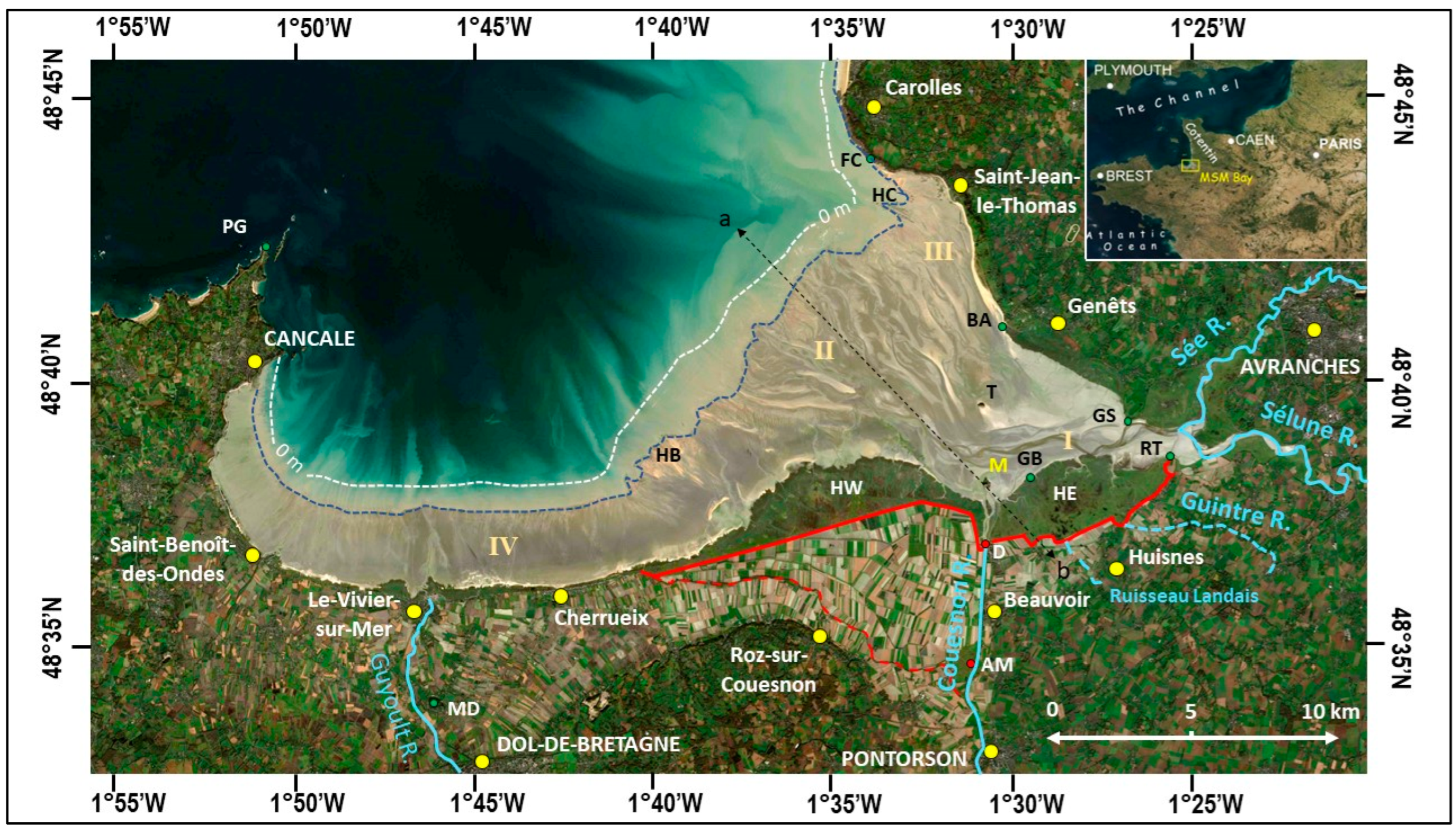


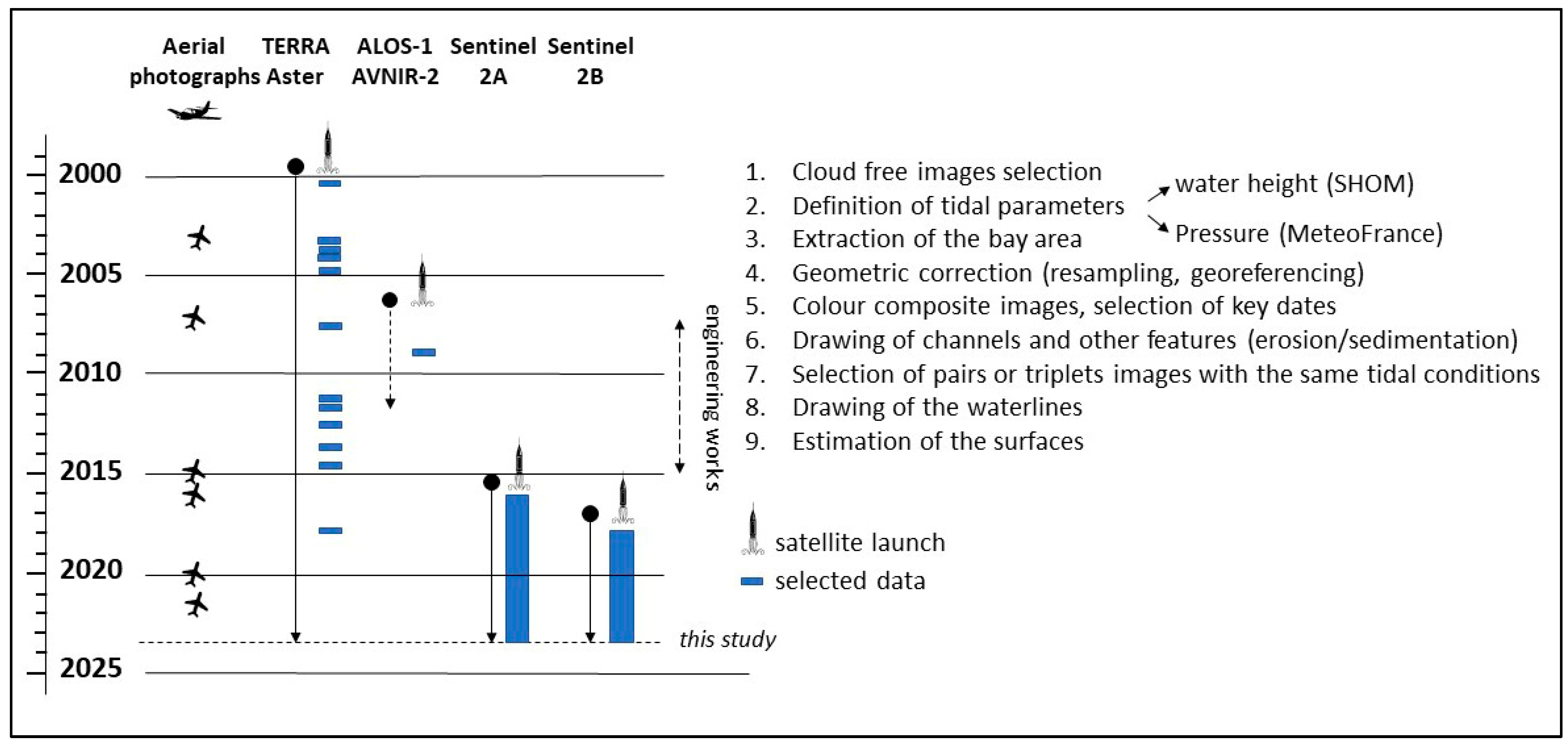
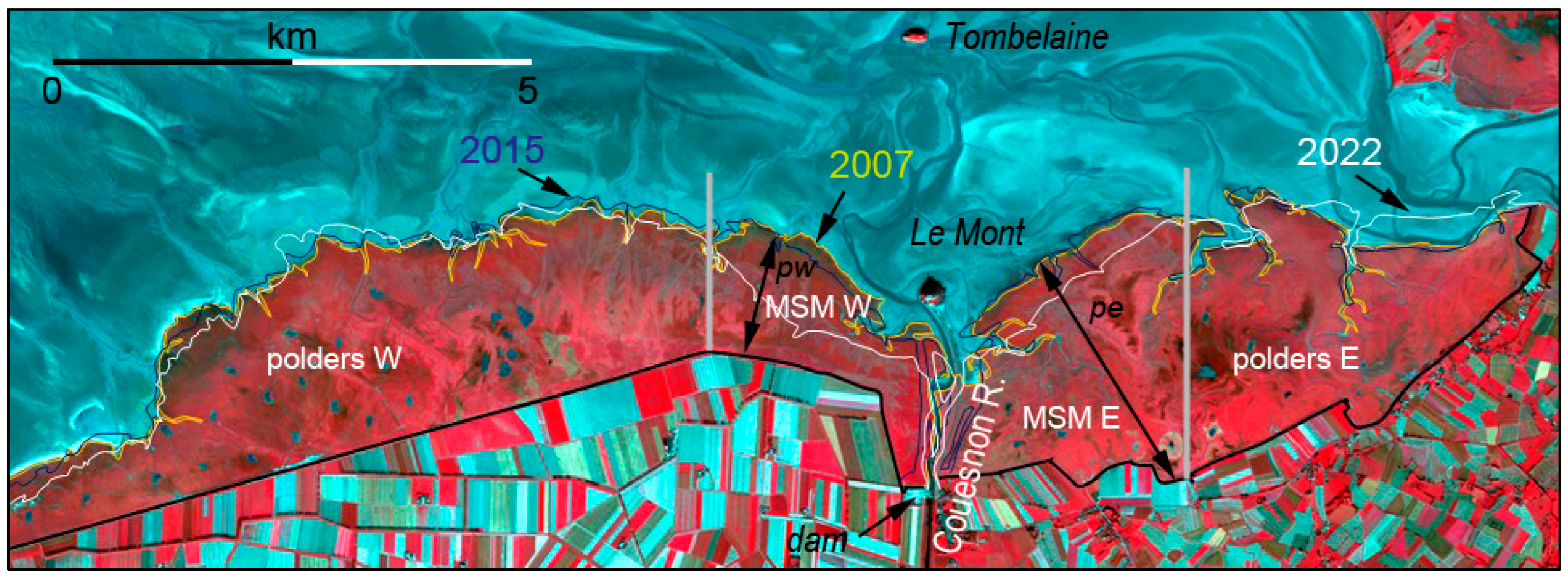
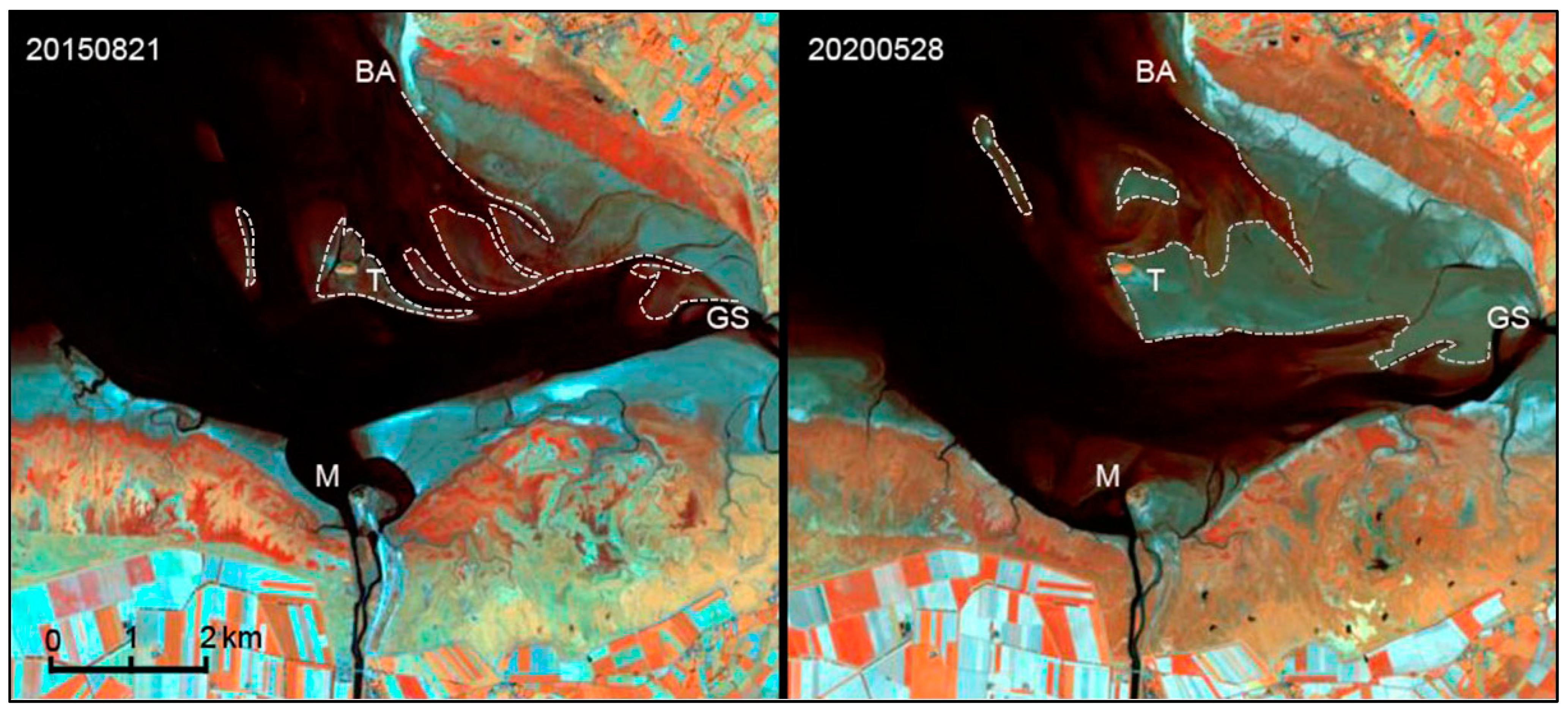
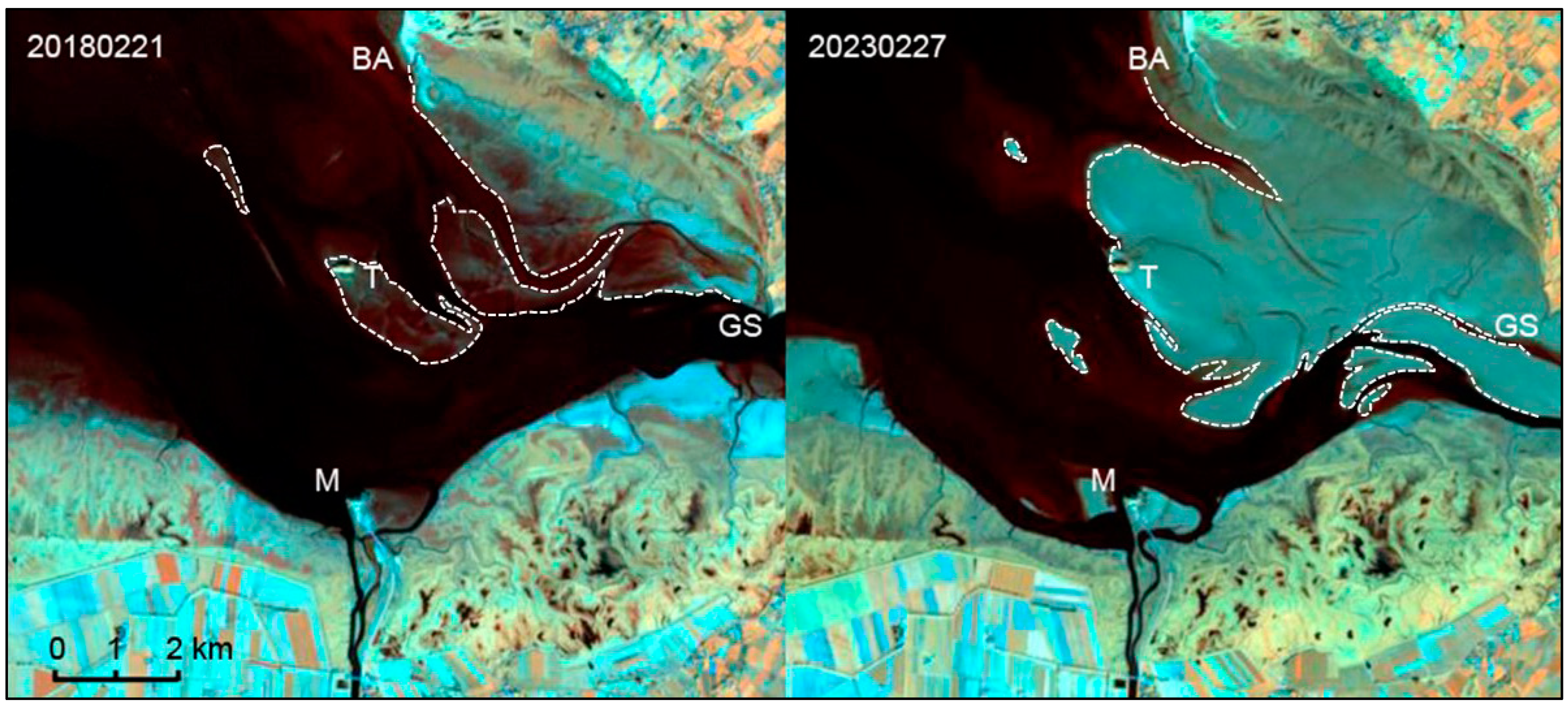


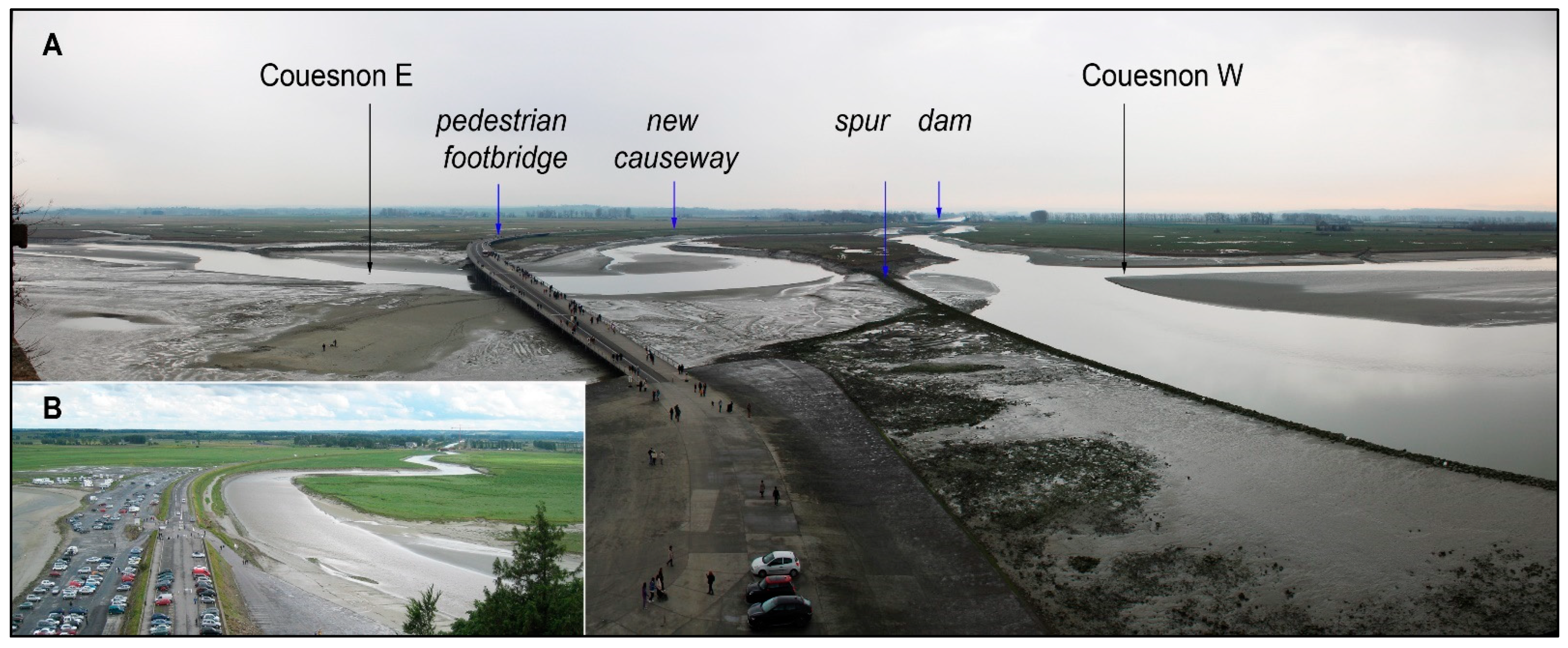

| S2-Spectral Range | Clear Water | Turbid Water | Humid Sediments | Dry Sediments | Vegetation Grand Banc | Vegetation Salt Meadows |
|---|---|---|---|---|---|---|
| Band 2 (497 nm) | 12.9 ± 1.22 | 19.8 ± 0.21 | 19.2 ± 0.98 | 25.8 ± 0.99 | 12.9 ± 0.90 | 13.7 ± 0.59 |
| Band 3 (560 nm) | 12.8 ± 1.20 | 23.4 ± 0.17 | 21.5 ± 1.27 | 27.9 ± 0.99 | 16.1 ± 0.67 | 18.0 ± 0.53 |
| Band 4 (664 nm) | 10.2 ± 0.95 | 22.9 ± 0.59 | 21.5 ± 1.08 | 28.5 ± 1.15 | 14.0 ± 1.45 | 14.9 ± 0.75 |
| Band 5 (704 nm) | 10.0 ± 0.93 | 24.1 ± 0.92 | 22.4 ± 1.09 | 30.1 ± 1.19 | 20.3 ± 0.65 | 24.0 ± 0.43 |
| Band 6 (740 nm) | 9.6 ± 0.90 | 18.8 ± 1.56 | 20.8 ± 2.34 | 29.7 ± 1.20 | 36.8 ± 6.78 | 44.2 ± 2.69 |
| Band 7 (782 nm) | 9.7 ± 0.90 | 18.8 ± 1.57 | 20.9 ± 2.37 | 29.9 ± 1.21 | 40.8 ± 8.00 | 48.3 ± 3.12 |
| Band 8 (835 nm) | 9.7 ± 0.91 | 15.8 ± 1.37 | 20.5 ± 3.48 | 30.5 ± 1.35 | 42.0 ± 8.80 | 51.2 ± 3.10 |
| Band 11 (1614 nm) | 9.9 ± 0.91 | 10.3 ± 0.10 | 16.4 ± 5.07 | 34.2 ± 2.85 | 26.4 ± 5.18 | 36.3 ± 1.08 |
| Band 12 (2202 nm) | 10.0 ± 0.92 | 10.3 ± 0.10 | 14.3 ± 3.92 | 30.9 ± 3.44 | 18.2 ± 2.37 | 23.4 ± 0.53 |
| Ratios | ||||||
| NDVI | −0.02 | −0.18 | −0.02 | 0.03 | 0.50 | 0.55 |
| NDWI | −0.01 | 0.21 | 0.11 | −0.06 | 0.23 | 0.17 |
| Brightness Index | 14.1 | 27.9 | 29.7 | 41.8 | 44.3 | 53.3 |
| Date | Polders W | MSM W | Total W | MSM E | Polders E | Total E | Couesnon | Grand Total |
|---|---|---|---|---|---|---|---|---|
| 20000407 | 1077.2 | 254.4 | 1331.6 | 488.1 | 571.5 | 1059.6 | 2391.2 | |
| 20040909 | 1199.6 | 281.1 | 1480.7 | 511.5 | 551.7 | 1063.3 | 2544.0 | |
| 20071024 | 1194.8 | 285.7 | 1480.5 | 535.9 | 604.5 | 1140.4 | 2620.9 | |
| 20120526 | 1176.0 | 259.8 | 1435.8 | 501.3 | 606.8 | 1108.1 | 2543.9 | |
| 20150801 | 1214.0 | 251.3 | 1465.3 | 493.7 | 628.7 | 1122.4 | 14.5 | 2602.3 |
| 20161031 | 1225.0 | 243.4 | 1468.4 | 518.6 | 616.7 | 1135.3 | 9.7 | 2613.4 |
| 20171113 | 1213.8 | 225.0 | 1438.8 | 502.9 | 621.2 | 1124.1 | 12.6 | 2575.4 |
| 20181021 | 1224.7 | 214.3 | 1439.1 | 508.5 | 629.9 | 1138.4 | 8.7 | 2586.1 |
| 20190919 | 1226.6 | 190.6 | 1417.3 | 489.5 | 641.3 | 1130.8 | 9.2 | 2557.2 |
| 20200913 | 1236.7 | 178.2 | 1414.9 | 466.7 | 661.2 | 1127.9 | 9.3 | 2552.0 |
| 20211008 | 1236.6 | 162.6 | 1399.2 | 475.6 | 664.6 | 1140.2 | 10.2 | 2549.6 |
| 20221020 | 1217.9 | 150.2 | 1368.1 | 448.3 | 684.1 | 1132.4 | 9.0 | 2509.5 |
| 20230408 | 1228.9 | 132.5 | 1361.4 | 469.2 | 644.3 | 1113.6 | 7.5 | 2482.4 |
Disclaimer/Publisher’s Note: The statements, opinions and data contained in all publications are solely those of the individual author(s) and contributor(s) and not of MDPI and/or the editor(s). MDPI and/or the editor(s) disclaim responsibility for any injury to people or property resulting from any ideas, methods, instructions or products referred to in the content. |
© 2023 by the author. Licensee MDPI, Basel, Switzerland. This article is an open access article distributed under the terms and conditions of the Creative Commons Attribution (CC BY) license (https://creativecommons.org/licenses/by/4.0/).
Share and Cite
Deroin, J.-P. Evaluating the Impact of Engineering Works in Megatidal Areas Using Satellite Images—Case of the Mont-Saint-Michel Bay, France. GeoHazards 2023, 4, 453-474. https://doi.org/10.3390/geohazards4040026
Deroin J-P. Evaluating the Impact of Engineering Works in Megatidal Areas Using Satellite Images—Case of the Mont-Saint-Michel Bay, France. GeoHazards. 2023; 4(4):453-474. https://doi.org/10.3390/geohazards4040026
Chicago/Turabian StyleDeroin, Jean-Paul. 2023. "Evaluating the Impact of Engineering Works in Megatidal Areas Using Satellite Images—Case of the Mont-Saint-Michel Bay, France" GeoHazards 4, no. 4: 453-474. https://doi.org/10.3390/geohazards4040026





